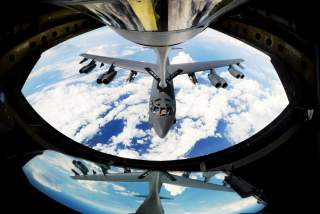America and Russia are Headed Toward a Hypersonic Showdown
This is what Moscow’s recent crop of nuclear and hypersonic weapons actually means for Washington.
This continuous development and deployment of new weapons that occupy a niche below the level of the global strategic deterrent should be a cause for concern. The IISS Military Balance for 2018 (quoted by Anthony Cordesman) states that: “Moscow appears to be maintaining a high degree of ambiguity about its intentions and capabilities that make it very difficult to completely rule out the possibility of a limited use of nuclear weapons in some eventuality.” It would appear that Russia is intent on shaping a strategic environment beyond its Western borders, in effect as far as an Iskander can fly, which would allow it to expand the military dimension of its security belt anywhere in what it refers to as the “Russian world.” The hope is that these systems will help Russia to intervene militarily in any acute political crisis in her near abroad, while NATO’s response will be hopelessly delayed for fear of Russia’s nuclear forces in the theater.
All these developments and Russia’s strenuous pursuit of hypersonics and nuclear capabilities as an integral part of these systems, only make matters worse for the United States. As hypersonic speeds dramatically reduce both the time required to reach a target and the probability of a successful interception, they can seriously affect the overall strategic balance—in effect acting as “destabilizing agents.” This is because the likelihood of launching a successful, pre-emptive, but sub-strategic strike must rise, as the inability of the current missile defense systems to deal with hypersonic missiles effectively makes them invulnerable. At the same time, and because these systems are essentially tactical in nature, the hope is that a general, strategic nuclear exchange can still be prevented with some adroit diplomacy at the time. Under these circumstances, Russia’s motivation in continuing this development seem clear. At a stroke, these could prove to be an effective counter to any NATO response forces, forward deployed in times of tension.
This is not the time for America to fall behind in this crucial hypersonic arena. One of the advantages of supreme military power is that it can give you strategic choices. In effect, if you are driving the pace of innovation, and hold the world’s most powerful military, you can effectively force everyone else to react to your moves. You alone are free to make strategic choices, secure in the knowledge that, if chosen well, the steps taken are sure to cause your competitors even greater headaches by driving them into areas that are disproportionately difficult for them. If you lose this dominance, even in one crucial field, the effects can be devastating to one’s ability to control the escalation. With Russia seemingly intent on continuing to develop and deploy sophisticated, and in some cases, unique nuclear-delivery systems, there is an urgent need for the United States to reassess its position.
Angus Ross is a professor of Joint Military Operations at the Naval War College and something of an amateur historian, while Andrew Savchenko writes on political risk in the post-Soviet space and teaches Economy and Society at RISD. The views expressed here are theirs alone.
Image: A U.S. Air Force B-52 Stratofortress aircraft assigned to Barksdale Air Force Base, La., receives fuel from a KC-135 Stratotanker out of RAF Mildenhall, England, above the Mediterranean Sea, Sept. 27, 2017. The B-52 is a long-range, heavy bomber that can perform a variety of missions. During this flight, the KC-135 offloaded 55,000 pounds of fuel to the B-52. (U.S. Air Force photo by Senior Airman Tenley Long). Flickr / U.S. Department of Defense

